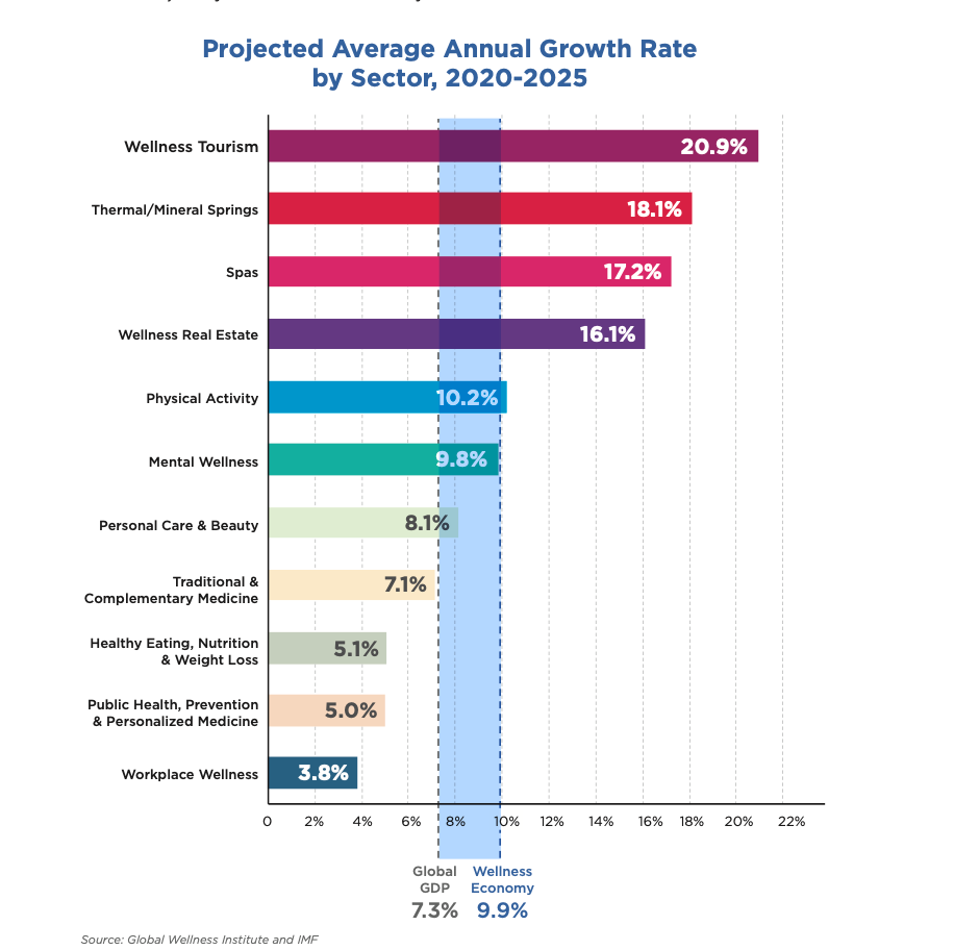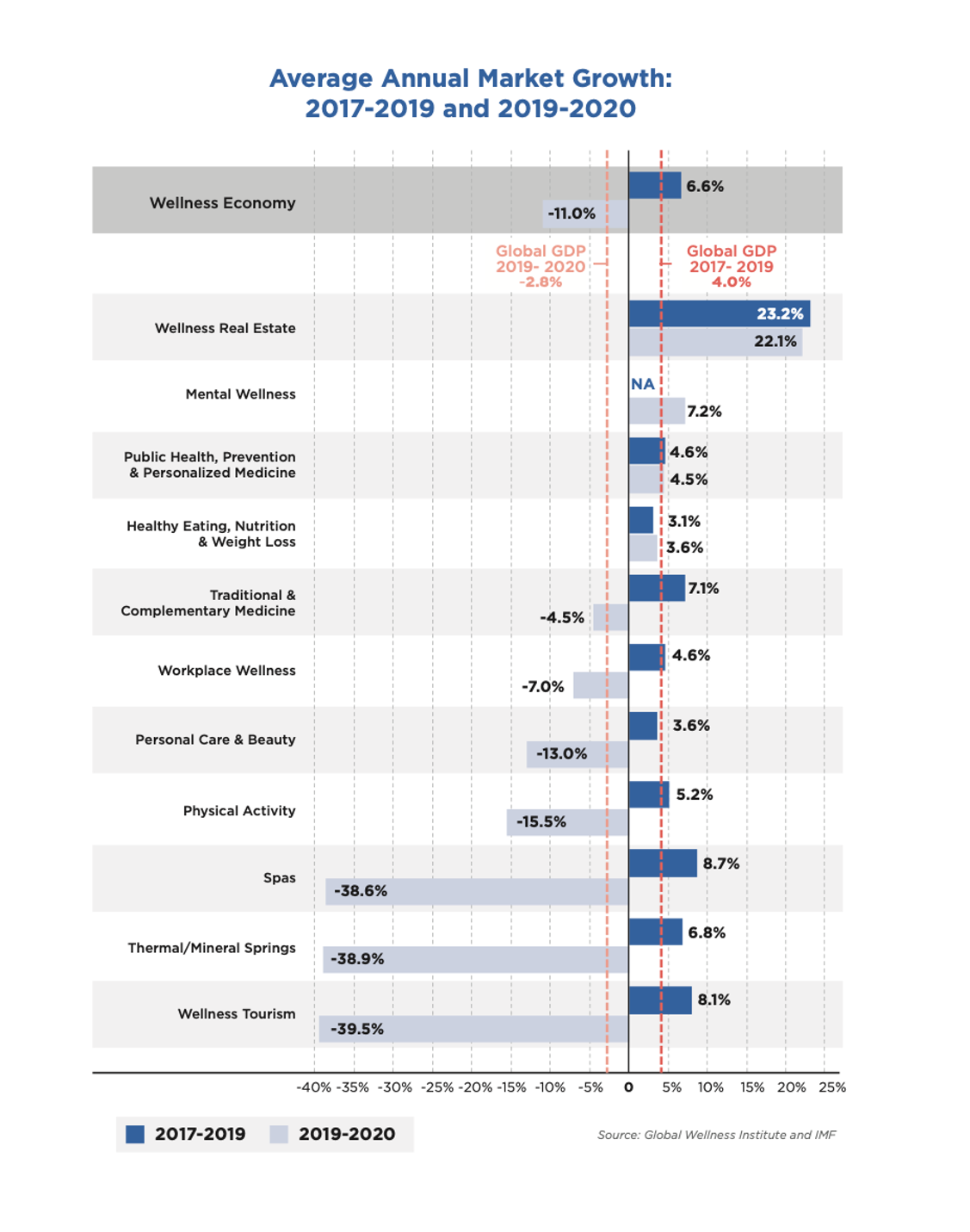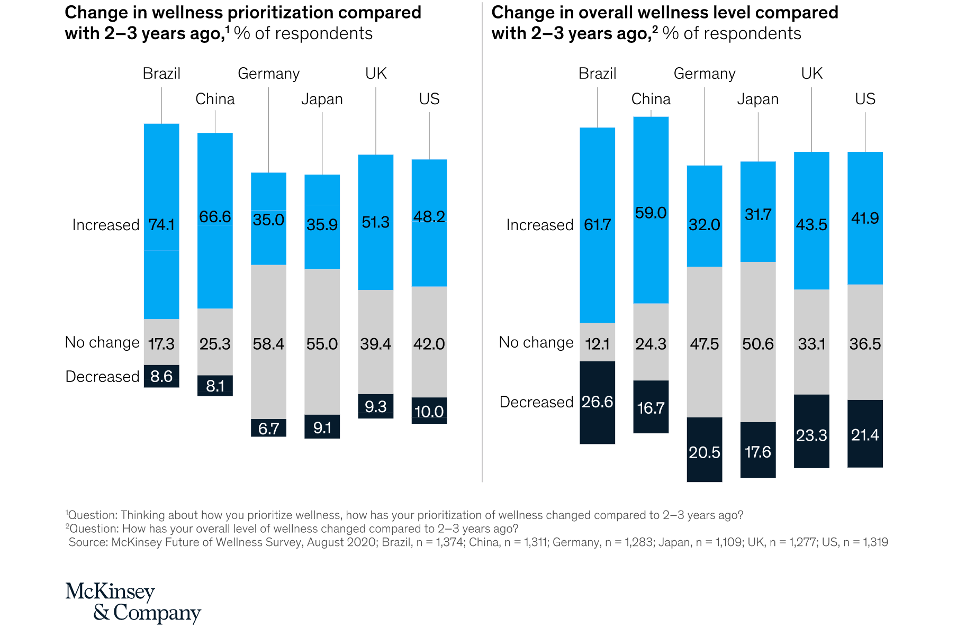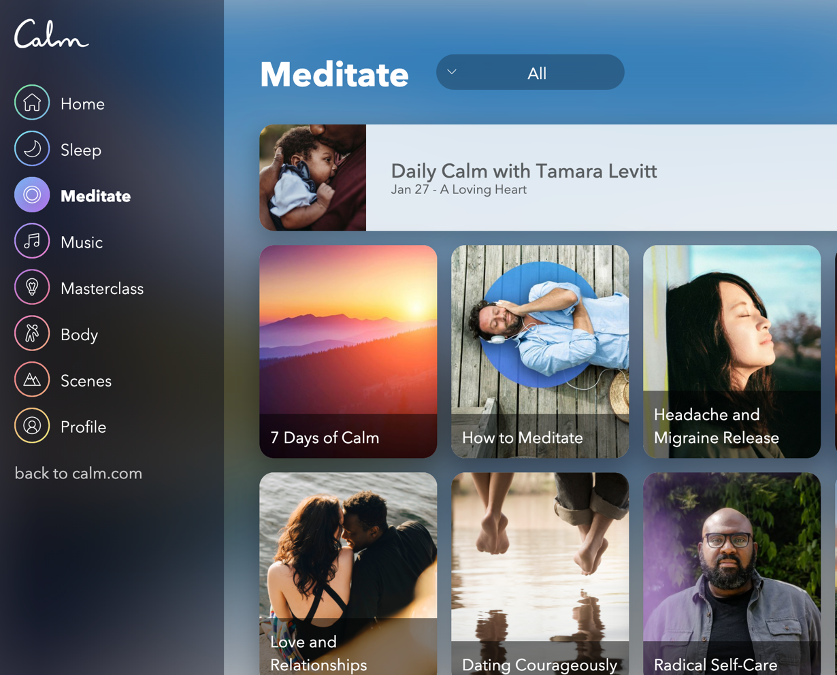The healthcare market took a hit in 2020. (What didn’t?)
And, with consumer interest in pretty much everything falling off during that fateful year—and inflation headlines flooding our collective consciousness in 2021—it’s easy to assume both spending and engagement are on a permanent downward trend as we progress this year.
But a new report suggests there’s at least one area where demand hasn’t simply bounced back to normal, pre-pandemic levels…
It’s actually thriving like never before.
Say hello to the 2022 wellness economy.
What “wellness” is
Recent findings from the Global Wellness Institute (GWI) cite wellness—i.e., market segments dedicated to the “active pursuit of activities, choices, and lifestyles that lead to a state of holistic health”—as a $4.4 trillion global industry (in 2020), with many subsectors poised for “robust growth” as the world begins to emerge from COVID-era setbacks.

GWI projections indicate the wellness economy will surpass global GDP growth levels over the next three years.
Segments of the wellness economy include:
- fitness—home equipment, training services, yoga accessories, and exercise apps
- nutrition—food and beverage subscriptions, vitamins, dieting services/guides, etc.
- beauty—cosmetics, anti-aging products, dental care, and hair care
- personalized medicine—personalized diagnostics and therapeutics, preventative medicine, and telemedicine
- complementary medicine—herbal supplements and essential oils
…among others.
And though some of these reported a definite dip in sales during 2020 (as would be expected), some fared even better than they did in 2019.
The segment that fared best?
Mental wellness.
Addressing “Second Pandemic” demand
It’s hardly a secret the stressors, strains, and anxieties of COVID life quickly gave way to a global mental health crisis, occasionally referred to as the “Second Pandemic.”
With as many as 41% of Americans (Source: Mental health technology transfer center network) pointing to at least some type of pandemic-related “adverse mental health condition” as early as June 2020, consumers have been urgently seeking products and practices that support mental wellness ever since.
Posting a 7.2% global increase in 2020 overall, mental wellness (an economic segment representing nearly all products and services aimed at promoting general mental/emotional wellbeing) seems to have “won” the COVID-era wellness economy race.
Mental wellness seems to have won the COVID-era wellness economy race.
In fact, according to GWI, no other segments comes close:

Average wellness market growth figures (pre- and post-pandemic)
With immense growth comes immense demand.
From cognitive therapy to meditative breathing and sleep-inducing digital apps, the quest for good mental health and genuine internal calm is expanding. This is especially true in North America, where mental wellness spending outperformed other regional markets by large margins.
As a result, certain practitioners are currently experiencing dizzying levels of demand, with some struggling to manage the sudden influx of prospective clients and, in certain cases, even turning away potential patients.

Global interest in overall “wellness” is on the rise as our general wellbeing experiences a post-COVID downturn.
This not only cuts back on provider revenue streams, it can also exacerbate the overarching problem as comfort and care are continuously denied to those who need it: a frightening concept, particularly when we consider much of mental wellness depends on forecast and prevention. (An idea emphasized in another report from the Global Wellness Institute, Defining the Mental Wellness Economy, November 2020.)
Managing the mental wellness wave
Thankfully, there are a lot of strategic options for mental health providers hoping to nurture and engage a newly galvanized population of patients.
Here are just a few suggestions for building a more immersive and responsive mental health practice in 2022 (and beyond):
Automate and align behind the scenes
The more in sync your information systems are, the easier it will be to onboard new patients, access essential records, and stay connected with clients via text or email. HIPAA-compliant email automation tools can help here, as can a HIPAA-compliant customer relationship management (CRM) platform. Both can ease communications backlogs and help maintain consistent scheduling for you and your patients.
Keep in contact beyond the weekly session
Luckily, technology affords several opportunities to ensure existing patients stay engaged between sessions. There are also digital outlets to help nurture prospective clients as they await clinical intake.
Engagement techniques can include outreach campaigns targeted to specific patients and their unique challenges (an e-newsletter series on coping with anxiety, say, which can be deployed via your automated email service). They can also include off-site hardware such as sleep and heartrate monitors, which can provide invaluable data and help inform future treatment plans.
Tech solutions can help ensure patient engagement and nurture prospective clients.
For wait-listed clients, practitioners can likewise keep lines of communication open via digital channels such as text or email. They can also offer interim help in the form of supportive apps like Tess, Calm, Headspace, or Synctuition.
Obviously these are only supplementary solutions. If you anticipate extended wait times, keep a list of colleagues on hand and be ready to provide referrals if necessary. If you’re completely booked for the foreseeable future, it’s also a good idea to stay on top of which local practitioners are able to accept new patients, as this can help prospectives minimize their search.

Some of the Calm app’s meditative offerings
Personalize as best you can
No one enjoys the feeling of being “just a number.” Indeed, a full 88% of US consumers are prioritizing the “personal touch” as much or more than just two or three years ago.
Avoid alienating patients by personalizing your communications as much as possible.
Hint: This is where aligned systems will prove invaluable. With the help of a well-organized patient database, for example, you can be assured all contact info and health records are up to date, so you’ll never misspell a client’s name or get caught sending ineffectual/inapplicable material ever again.
Having trouble with your turn of phrase? Industry resources like this one can help get the ball rolling on patient emails and other interpersonal messages.
And finally…
Take the telehealth leap
2020 marked a “moment of truth” for telehealth as safety and convenience concerns launched a new culture of telemedicine. This was good news for mental health providers and patients, as dialectical treatments like talk therapy lend themselves easily to telehealth formats (such as the one-on-one video conference). Plus, digital health platforms offer a way to combat more practical mental health woes such as tiresome wait and travel times.
Today, telehealth usage is still hovering at 38 times the level of pre-pandemic adoption (as of December 2021). So, if you haven’t already, now’s the time to investigate extending your mental telehealth service, especially since telemedicine is where much of your practice is likely to “live.”
As of December 2021, telehealth usage is at 38 times what it was before the pandemic.
To better scale your telehealth practice and attract new telemedical patients, you’ll need:
- A comprehensive telehealth marketing plan. This will help you codify processes for reaching out to prospective patients and following up with existing clients. It will also help in finetuning your messaging, setting measurable goals, and balancing clinic-wide budgets.
- A meticulously managed website. A telehealth-focused site can act as a first point of contact for potential patients, process digital intake forms, and offer informative content surrounding current medical news and/or providing actionable mental healthcare advice.
- Inbound and outbound telehealth marketing strategies. For practices struggling to keep pace with demand, an inbound strategy can help nurture prospective patients with campaigns designed to encourage ongoing interaction (think: regular blog posts, doctor Q&A series, or email check-ins). For practices unsure of how to alert potential patients to their telehealth services, an outbound strategy can help spread the word via web listings, digital ads, and more traditional outlets like TV or radio.
- A set of workable tech tools. Tech solutions for automation, patient/record management, and appointment scheduling are a must for telehealth providers. As touched on above, these will help streamline communications and support continuity of care. They can also gather, measure, and analyze prospect/patient data to assist in future outreach or to gauge patient “temperatures” regarding current treatments.
Feeling a little overwhelmed? Start with a HIPAA-compliant CRM and work from there. An end-to-end CRM solution such as LeadSquared can serve as a telehealth skeleton key, unlocking all the implements and integrations you’ll need to keep track of patient data, assess behavioral trends, and facilitate better clinical and administrative service.
Long live the wellness economy. Here’s hoping our new passion for mental health inspires greater, more targeted avenues of compassionate care.







